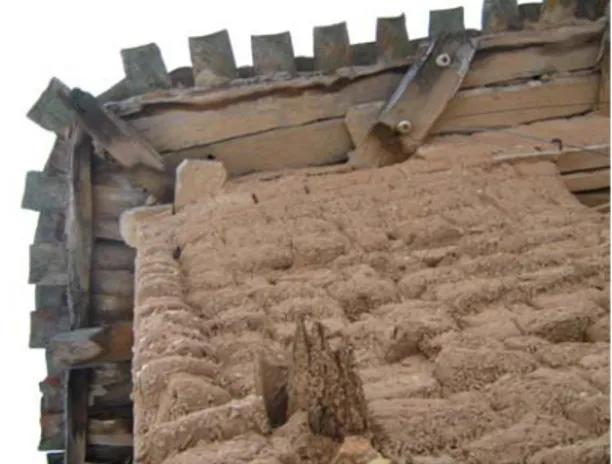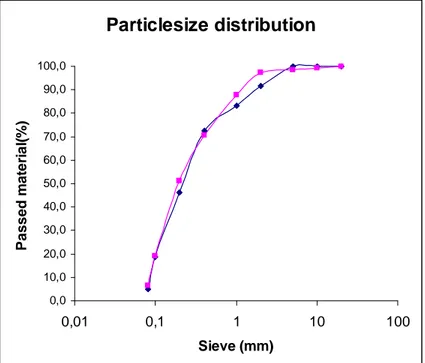Characterization of adobe blocks from burgos
Texto
(2) 6 ATP | 9 SIACOT. Figure 1 - House in Villasandino from which samples were extracted. Figure 2 – Detail of house in Villasandino from which samples were extracted. 3. TESTING PROCEDURES In order to study the adobe blocks a testing procedure was developed encompassing particle sieve analysis, Atterberg’s plastic and liquid limit, X-Ray diffraction, compressive strength, tensile strength and erosion test following the Geelong method. This set of tests is intended to provide information on the composition of these materials, their mechanical and physical characteristics and their rate of decay. • Particle sieve analysis Humid particle sieve analysis was performed for the determination of the percentage of fine particles, prior to dry particle sieve analysis, that was then performed on particles over 0.075 mm. For this test, the main ASTM sieve series was used. • Atterberg’s plastic limit Atterberg´s plastic limit was determined on the adobe particle fraction below 0.1 mm. Soil was rolled into ellipsoidal masses and the plastic limit was achieved with the execution of 3 mm threads. • Atterberg’s liquid limit The determination of the water content responsible for the transition of the soil from plastic to liquid state was performed using Casagrande apparatus and methodology. • X-Ray Diffraction Particles sized below 0.075mm and dried at 40ºC were subjected to XRD using an XPert Pro X-Ray Diffractometer in order to determine mineralogical composition. • Compressive strength This test was performed on cylindrical specimens with an average diameter of 80 mm both in terms of simple compressive strength and diametric compressive strength. • Durability Water behaviour was evaluated by a durability test following the Geelong method, based on New Zealand and Australian standards (NZS, 2000). This consists of the continuous fall of water droplets totalizing 100ml, from a height of 400mm, each 20min. The test is concluded by the measurement of the erosion produced and water penetration depth, followed by the determination of the erosion index. 4. RESULTS 2.
(3) 6 ATP | 9 SIACOT. • Particle size distribution Particle size distribution was performed on a sample from the traditional house and on a two samples from the wine cellar (Figure 3). Results showed that the adobe used in the house contained a greater percentage of sand (35%) in comparison to that extracted from the wine cellar (10%). Therefore, the adobe from the winery displayed a high content of very fine particles, below 0.06 mm, classified as silt and clay.. Particlesize distribution 100,0 90,0. Passed material(%). 80,0 70,0 60,0 50,0 40,0 30,0 20,0 10,0 0,0. 0,01. 0,1. 1. 10. 100. Sieve (mm). Figure 3 – Particle size distribution of adobes from the wine cellar. • Plastic and liquid limit Casagrande classification system was applied on samples from the rural house and wine cellar. While the sample from the house attained the classification of silt/clay with low plasticity (CL-ML), the winery sample was classified as low plasticity clay (CL) due to a liquid limit below 50% and a plastic limit above 7%. • X-Ray diffraction Mineralogical characterization was performed on adobe from the wine cellar walls and on a sample of earth taken from the ceiling of the same wine cellar, which was partially excavated below the ground. Adobe samples were composed by quartz, calcite and feldspars, with traces of haematite. The analysed soil revealed a composition of quartz, calcite and illite, with traces of haematite. The presence of calcite in the adobe did not seem to be due to the addition of lime, owing to its colouring and consistence and the presence of a great amount of calcite in the soil suggests that it was probably used for the manufacture of adobes. Due to its content in calcite and to the geological context of the region, the soil may be classified as a Terra Rossa. • Mechanical strength Mechanical strength tests, comprising compressive (Table 1) and indirect tensile (Table 2) strength, were performed on samples from the rural residential house. The obtained results showed a high dispersion of values, with compressive strength ranging from 1.2MPa to 3.0MPa and tensile strength surrounding 0.25MPa up to 0.32MPa. Due to the heterogeneity of these materials and their manufacture process, this variation in values is common (Varum et al, 2006; Gonzalez, 1999). The ratio. 3.
(4) 6 ATP | 9 SIACOT. between the average tensile and compressive strength is 0.14, also a typical value for these earth based materials. Table 1 – Compressive strength (MPa) of adobe specimens from the rural house. Specimen # 1 2 3 4 5 Average. Stress strength (MPa) 1.87 1.24 3.01 2.19 2.09 2.08. Table 2 – Tensile strength (MPa) of adobe specimens from the rural house. Specimen # 6 7 8 9 10 Average. Stress strength (MPa) 0.31 0.25 0.32 0.29 0.28 0.29. • Erosion tests (Geelong Method) Erosion index was determined by the erosion depth produced by the water drops and resulted in a classification of adobes as generally suitable for use in protected external walls except for Sample 3, with a recommended application encompassing exposed external walls (Table 3).. Adobe Sample 1 Sample 2 Sample 3. Table 3 – Adobe classification in terms of erosion Recommended Penetration Erosion index use depth Protected 3 <8cm external walls Protected 3 <8cm external walls Exposed 2 <8cm external walls. Conclusion Approved Approved Approved. In terms of penetration depth, all adobes were considered approved (Table 3) as water didn’t exceed the depth of 120mm measured from the adobe surface. CONCLUSION Adobes from Villasandino, Burgos, extracted from two different buildings show some variation in terms of composition. However, it became clear that they are made from local materials and do not incorporate lime. Adobes from the same building show variations in terms of mechanical and physical characteristics, as is common with this kind of materials. However, the values encountered for mechanical strength are within usual limits. Erosion by water action wasn’t severe and indicates that these adobes are prone for use in external walls, with some protection. Although these materials suffer constant freeze-thaw cycles, their properties do not seem to be much affected by these, probably due to their porous structure.. 4.
(5) 6 ATP | 9 SIACOT. References Arango-Gonzalez, J. R. (1999). Uniaxial deformation-stress behaviour of the rammedearth of the Alcazaba Cadima. Materials and Structures 32, pp.70-74. Delgado, M. and Guerrero, I. (2006). Earth building in Spain. Construction and Building Materials 20, pp. 679-690. Graciani-García, A.; Tabales-Rodríguez, M. Á. (2003). Typological observations on tapia walls in the area of Seville. First International Congress on Construction History, Madrid, pp.1093-1106. NZS 4298:1998 (2000). New Zealand Standard: Materials and workmanship for earth buildings. Varum, H.; Costa, A.; Velosa, A.; Martins, T.; Pereira, H. and Almeida, J. (2006) Caracterização mecânica e patológica das construções em adobe no distrito de Aveiro como suporte em intervenções de reabilitação - Projecto Culture 2000/Mediterrae Houses and cities built with earth: conservation, significance and urban quality. ARGUMENTUM, pp. 41-45. Curriculum Ana Velosa is Assistant Professor at the Department of Civil Engineering of the University of Aveiro, Portugal and a researcher at Geobiotec. Her main research area is building conservation, with a special emphasis on mortars and traditional construction materials. She has participated in several research projects and co-authored various publications in international journals and conferences. Humberto Varum is Assistant Professor in the Civil Engineering Department at the University of Aveiro, Portugal and researcher at the CEC, FEUP, Porto. His main research interests are: seismic assessment and strengthening of structures, earth construction. He has co-authored over 150 international publications. Maria Sáez, master student at the Civil Engineering Department of the University of Aveiro, Portugal.. 5.
(6)
Imagem



Documentos relacionados
(f) Quality map that is an input to the algorithm: white corresponds to pixels whose phase value is meaningless, and gray corresponds to the rest of the pixels... CAPE is
Starting from the scanning electronic microscopy characterizations, the chemical analysis for energy dispersive spectroscopy, and phase analysis by X-ray diffraction, the
one (or more, from a total of 14 blocks) is in place. The LNLS Magnet Group developed a special rig for handling the blocks. 2) Robust mechanical mounting of the electrically
Figure 1 shows the X-ray diffraction patterns of the samples prepared from refluxing (R1) and sonochemical (S1) methods. All the diffraction peaks in the X-ray diffraction
The characterization of this solid crystal structure using the Raman spectroscopy, X-ray Powder diffraction, Differential scanning calorimeter, thermogravimetric analysis and
The preliminary analysis was conducted for three days and consisted of placing a total of 120 traps in the four study neighbourhoods (30 blocks/neighbourhood), for
In order to identify new antinociceptive drug candidates, we described herein the design, synthesis, X-ray diffraction study and the pharmacological evaluation of a series of
história e filosofia das relações entre historiadores e filósofos, embora possa parecer uma falsa distinção na medida em que não pode haver relação entre história